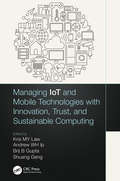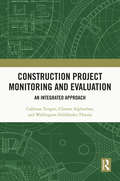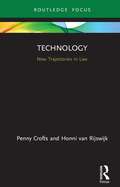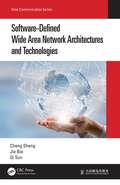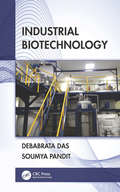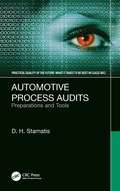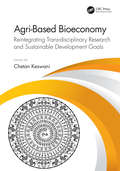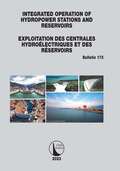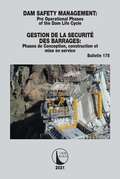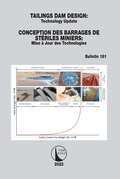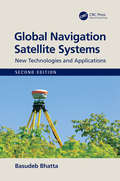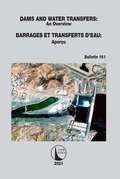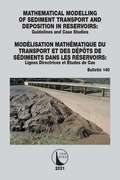- Table View
- List View
Managing IoT and Mobile Technologies with Innovation, Trust, and Sustainable Computing
by Kris M. Y. Law Andrew W. H. Ip Brij B. Gupta Shuang GengFocused on the latest mobile technologies, this book addresses specific features (such as IoT) and their adoptions that aim to enable excellence in business in Industry 4.0. Furthermore, this book explores how the adoption of these technologies is related to rising concerns about privacy and trusted communication issues that concern management and leaders of business organizations. Managing IoT and Mobile Technologies with Innovation, Trust, and Sustainable Computing not only targets IT experts and drills down on the technical issues but also provides readers from various groups with a well-linked concept about how the latest trends of mobile technologies are closely related to daily living and the workplace at managerial and even individual levels.
Construction Project Monitoring and Evaluation: An Integrated Approach (Routledge Research Collections for Construction in Developing Countries)
by Callistus Tengan Clinton Aigbavboa Wellington Didibhuku ThwalaThis book will provide readers with an in-depth theoretical awareness and practical guidance on the implementation of an effective monitoring and evaluation (M&E) system to ensure construction projects meet approved quality, cost, time and social sustainability objectives. The authors discuss the drivers, challenges, determinants and benefits of effective M&E implementation together with the theories and models underpinning construction project M&E practices. Further, a comparative overview of M&E practices in developed and developing countries is presented to elucidate the best practices. The book first conceptualizes M&E as a five-factor model comprising stakeholder involvement, budgetary allocation and logistics, technical capacity and training, leadership, and communication. It then presents an M&E case study on the Ghanaian construction industry before expanding on the idea of M&E systems as an effective tool for project performance and in optimizing a project’s contribution to society and the environment. The book further provides guidance on M&E practice for construction project managers, investors, professionals, researchers and other stakeholders and is therefore of interest to those in architecture, construction engineering, planning, project management and development studies.
Managing IoT and Mobile Technologies with Innovation, Trust, and Sustainable Computing
by Edited by Kris MY Law, Andrew WH Ip, Brij B Gupta and Shuang GengFocused on the latest mobile technologies, this book addresses specific features (such as IoT) and their adoptions that aim to enable excellence in business in Industry 4.0. Furthermore, this book explores how the adoption of these technologies is related to rising concerns about privacy and trusted communication issues that concern management and leaders of business organizations. Managing IoT and Mobile Technologies with Innovation, Trust, and Sustainable Computing not only targets IT experts and drills down on the technical issues but also provides readers from various groups with a well-linked concept about how the latest trends of mobile technologies are closely related to daily living and the workplace at managerial and even individual levels.
Construction Project Monitoring and Evaluation: An Integrated Approach (Routledge Research Collections for Construction in Developing Countries)
by Callistus Tengan Clinton Aigbavboa Wellington Didibhuku ThwalaThis book will provide readers with an in-depth theoretical awareness and practical guidance on the implementation of an effective monitoring and evaluation (M&E) system to ensure construction projects meet approved quality, cost, time and social sustainability objectives. The authors discuss the drivers, challenges, determinants and benefits of effective M&E implementation together with the theories and models underpinning construction project M&E practices. Further, a comparative overview of M&E practices in developed and developing countries is presented to elucidate the best practices. The book first conceptualizes M&E as a five-factor model comprising stakeholder involvement, budgetary allocation and logistics, technical capacity and training, leadership, and communication. It then presents an M&E case study on the Ghanaian construction industry before expanding on the idea of M&E systems as an effective tool for project performance and in optimizing a project’s contribution to society and the environment. The book further provides guidance on M&E practice for construction project managers, investors, professionals, researchers and other stakeholders and is therefore of interest to those in architecture, construction engineering, planning, project management and development studies.
Technology: New Trajectories in Law (New Trajectories in Law)
by Penny Crofts Honni van RijswijkPlacing contemporary technological developments in their historical context, this book argues for the importance of law in their regulation. Technological developments are focused upon overcoming physical and human constraints. There are no normative constraints inherent in the quest for ongoing and future technological development. In contrast, law proffers an essential normative constraint. Just because we can do something, does not mean that we should. Through the application of critical legal theory and jurisprudence to pro-actively engage with technology, this book demonstrates why legal thinking should be prioritised in emerging technological futures. This book articulates classic skills and values such as ethics and justice to ensure that future and ongoing legal engagements with socio-technological developments are tempered by legal normative constraints. Encouraging them to foreground questions of justice and critique when thinking about law and technology, the book addresses law students and teachers, lawyers and critical thinkers concerned with the proliferation of technology in our lives.
Software-Defined Wide Area Network Architectures and Technologies (Data Communication Series)
by Cheng Sheng Jie Bai Qi SunStarting with problems and challenges faced by enterprise WANs, Software-Defined Wide Area Network Architectures and Technologies provides a detailed description of SD-WAN’s background and basic features, as well as the system architecture, operating mechanism, and application scenarios of the SD-WAN solution based on the implementation of Huawei SD-WAN Solution. It also explains key SD-WAN technologies and analyzes real SD-WAN deployment cases, affording readers with design methods and deployment suggestions for the SD-WAN solution. The information presented in this book is easy to understand and very practical. It enables you to become adept in the SD-WAN solution’s implementation and design principles. The book is intended for ICT practitioners, such as network technical support engineers, network administrators, and network planning engineers, to use in studying theory. Furthermore, it serves as reference material for network technology enthusiasts. Authors Cheng Sheng is the Chief Architect of Huawei’s SD-WAN Solution. He has nearly 20 years of experience in network product and solution design, as well as extensive expertise in product design and development, network planning and design, and network engineering project implementation. Jie Bai is an Architect of Huawei’s SD-WAN Solution. He is well versed in Huawei security products and SD-WAN Solution and has written books such as Huawei Firewall Technology Talk as well as Huawei Anti-DDoS Technology Talk. Qi Sun is a Senior Information Architect of Huawei, and he is knowledgeable in Huawei SD-WAN Solution, CloudVPN Solution, and Cloud Management Solution. He also participated in the information architecture design and delivery of multiple solutions.
Software-Defined Wide Area Network Architectures and Technologies (Data Communication Series)
by Cheng Sheng Jie Bai Qi SunStarting with problems and challenges faced by enterprise WANs, Software-Defined Wide Area Network Architectures and Technologies provides a detailed description of SD-WAN’s background and basic features, as well as the system architecture, operating mechanism, and application scenarios of the SD-WAN solution based on the implementation of Huawei SD-WAN Solution. It also explains key SD-WAN technologies and analyzes real SD-WAN deployment cases, affording readers with design methods and deployment suggestions for the SD-WAN solution. The information presented in this book is easy to understand and very practical. It enables you to become adept in the SD-WAN solution’s implementation and design principles. The book is intended for ICT practitioners, such as network technical support engineers, network administrators, and network planning engineers, to use in studying theory. Furthermore, it serves as reference material for network technology enthusiasts. Authors Cheng Sheng is the Chief Architect of Huawei’s SD-WAN Solution. He has nearly 20 years of experience in network product and solution design, as well as extensive expertise in product design and development, network planning and design, and network engineering project implementation. Jie Bai is an Architect of Huawei’s SD-WAN Solution. He is well versed in Huawei security products and SD-WAN Solution and has written books such as Huawei Firewall Technology Talk as well as Huawei Anti-DDoS Technology Talk. Qi Sun is a Senior Information Architect of Huawei, and he is knowledgeable in Huawei SD-WAN Solution, CloudVPN Solution, and Cloud Management Solution. He also participated in the information architecture design and delivery of multiple solutions.
Industrial Biotechnology
by Debabrata Das Soumya PanditIndustrial Biotechnology offers a comprehensive overview of biochemical processes, technologies, and practical applications of industrial biotechnology. The work comprises of chapters that discuss medium preparation, inoculum preparation using industrial strain and upstream processing, various fermentation processes, and physico-chemical separation processes for the purification of products and packaging. Analyzes problems within biochemical processes Discusses stoichiometry of bioprocesses Covers upstream and downstream processing Offers a wealth of case studies of different biochemical production processes, including those in development of food products, vaccines and medicines, single cell proteins, amino acids, cheese, biodiesel, biopesticides, and more This book is aimed at advanced students, industrial practitioners, and researchers in biotechnology, food engineering, chemical engineering, and environmental engineering.
Industrial Biotechnology
by Debabrata Das Soumya PanditIndustrial Biotechnology offers a comprehensive overview of biochemical processes, technologies, and practical applications of industrial biotechnology. The work comprises of chapters that discuss medium preparation, inoculum preparation using industrial strain and upstream processing, various fermentation processes, and physico-chemical separation processes for the purification of products and packaging. Analyzes problems within biochemical processes Discusses stoichiometry of bioprocesses Covers upstream and downstream processing Offers a wealth of case studies of different biochemical production processes, including those in development of food products, vaccines and medicines, single cell proteins, amino acids, cheese, biodiesel, biopesticides, and more This book is aimed at advanced students, industrial practitioners, and researchers in biotechnology, food engineering, chemical engineering, and environmental engineering.
Automotive Process Audits: Preparations and Tools (Practical Quality of the Future)
by D. H. StamatisWith a detailed discussion on the preparation and tools needed for an automotive process audit, this book addresses the fundamental issues and concerns by focusing on two objectives: explaining the methods and tools used in the process for the organization, and provide a reference or manual for dealing with documenting quality issues. This book addresses the fundamental issues and concerns for a successful automotive process audit and details specifically how to prepare for it. It presents a complete assessment of what an organization must do to earn certification in ISO standards, industry standards, and customer-specific requirements. It also focuses on the efficiency of resources within an organization so that an audit can be successful and describes the methodologies to optimize the process by knowing what to do, what to say, and how to prove it. A road map is offered for the "process audit" and the "layered audit," and defines a clear distinction between the preparation details for each. This book is intended for those that conduct audits, those who are interested in auditing, and those who are being audited. It specifically addresses how to prepare for an automotive process audit for readers who are involved in quality, manufacturing, and operations management, and those who work with suppliers.
Automotive Process Audits: Preparations and Tools (Practical Quality of the Future)
by D. H. StamatisWith a detailed discussion on the preparation and tools needed for an automotive process audit, this book addresses the fundamental issues and concerns by focusing on two objectives: explaining the methods and tools used in the process for the organization, and provide a reference or manual for dealing with documenting quality issues. This book addresses the fundamental issues and concerns for a successful automotive process audit and details specifically how to prepare for it. It presents a complete assessment of what an organization must do to earn certification in ISO standards, industry standards, and customer-specific requirements. It also focuses on the efficiency of resources within an organization so that an audit can be successful and describes the methodologies to optimize the process by knowing what to do, what to say, and how to prove it. A road map is offered for the "process audit" and the "layered audit," and defines a clear distinction between the preparation details for each. This book is intended for those that conduct audits, those who are interested in auditing, and those who are being audited. It specifically addresses how to prepare for an automotive process audit for readers who are involved in quality, manufacturing, and operations management, and those who work with suppliers.
Agri-Based Bioeconomy: Reintegrating Trans-disciplinary Research and Sustainable Development Goals
by Chetan KeswaniThis volume concentrates on the recent scientific advancements in agricultural biotechnology and reintegrates it with socio-economic, industrial and intellectual property aspects of agricultural biotechnology and its implications for accomplishing the sustainable development goals. Adopting a unique approach, this book amalgamates science and business perspectives from an insider’s viewpoint on the agro-biotech industry, laying the foundations for students and professionals alike. This book: Is a first of its kind by addressing the recent issues emerging in agro-based economies. Will be a single-point source for recent advancements in agro-based global bioeconomy. Empowers the utilization of biotechnology to address worldwide ecological issues by supporting sustainable resolutions for global agricultural markets. Gives both foundational hypothesis and functional direction on commercialization and regulatory issues. Empowers the usage of adaptable approaches that can adjust to and uphold socially and financially valuable agro-based technologies.
Agri-Based Bioeconomy: Reintegrating Trans-disciplinary Research and Sustainable Development Goals
by Chetan KeswaniThis volume concentrates on the recent scientific advancements in agricultural biotechnology and reintegrates it with socio-economic, industrial and intellectual property aspects of agricultural biotechnology and its implications for accomplishing the sustainable development goals. Adopting a unique approach, this book amalgamates science and business perspectives from an insider’s viewpoint on the agro-biotech industry, laying the foundations for students and professionals alike. This book: Is a first of its kind by addressing the recent issues emerging in agro-based economies. Will be a single-point source for recent advancements in agro-based global bioeconomy. Empowers the utilization of biotechnology to address worldwide ecological issues by supporting sustainable resolutions for global agricultural markets. Gives both foundational hypothesis and functional direction on commercialization and regulatory issues. Empowers the usage of adaptable approaches that can adjust to and uphold socially and financially valuable agro-based technologies.
Integrated Operation of Hydropower Stations and Reservoirs/Exploitation des centrales hydroélectriques et des Réservoirs (ICOLD Bulletins Series #173)
Integrated operation of hydropower stations and reservoirs has become a trend of hydropower exploitation, as an effective technical measure, integrated operation can improve the utilization efficiency of water resources, reduce the risks of flood and drought disaster, increase the safety and stability power grid and make sure that hydropower stations and reservoirs operate in an appropriate and economical way. This bulletin gives an overview of the main functional and operational aspects relating to cascade hydropower stations and reservoirs, it was formed by reviewing of all the related aspects proposed and case studies provided by committee members. It collected and sorted out operation modes and practical experiences of hydropower stations and reservoirs in ICOLD member countries, summarized the feasibility measures, benefit evaluation methods and system platform construction of hydropower stations and reservoirs with comprehensive benefits, and shared case studies from 10 countries, including Brazil, China, France, Iran, Japan, Korea, Nigeria, Russia, Switzerland and USA. L'exploitation intégrée des centrales hydroélectriques et des réservoirs est devenue une mesure technique efficace de l'exploitation hydroélectrique. L'exploitation intégrée peut améliorer l'efficacité d'utilisation des ressources en eau, réduire les risques de catastrophe, d'inondation et de sécheresse, augmenter la sécurité et la stabilité du réseau électrique et faire fonctionner les centrales hydroélectriques et les réservoirs de manière appropriée et économique. Ce bulletin donne un aperçu des principaux aspects fonctionnels et opérationnels relatifs aux centrales hydroélectriques et réservoirs en cascade. Il passe en revue tous les aspects connexes proposés et des études de cas fournies par les membres du comité. Il rassemble les modes de fonctionnement et les expériences pratiques des centrales hydroélectriques et des réservoirs dans les pays membres de la CIGB. Il résume les mesures de faisabilité, les méthodes d'évaluation des avantages et la construction de plates-formes de systèmes de centrales hydroélectriques et de réservoirs avec des avantages complets. Il bénéficie des expériences et des études de cas de 10 pays, y compris Brésil, Chine, Corée, France, Iran, Japon, Nigéria, Russie, Suisse et USA.
Integrated Operation of Hydropower Stations and Reservoirs/Exploitation des centrales hydroélectriques et des Réservoirs (ICOLD Bulletins Series #173)
by International Commission on Large Dams Commission Internationale Des Grands BarragesIntegrated operation of hydropower stations and reservoirs has become a trend of hydropower exploitation, as an effective technical measure, integrated operation can improve the utilization efficiency of water resources, reduce the risks of flood and drought disaster, increase the safety and stability power grid and make sure that hydropower stations and reservoirs operate in an appropriate and economical way. This bulletin gives an overview of the main functional and operational aspects relating to cascade hydropower stations and reservoirs, it was formed by reviewing of all the related aspects proposed and case studies provided by committee members. It collected and sorted out operation modes and practical experiences of hydropower stations and reservoirs in ICOLD member countries, summarized the feasibility measures, benefit evaluation methods and system platform construction of hydropower stations and reservoirs with comprehensive benefits, and shared case studies from 10 countries, including Brazil, China, France, Iran, Japan, Korea, Nigeria, Russia, Switzerland and USA. L'exploitation intégrée des centrales hydroélectriques et des réservoirs est devenue une mesure technique efficace de l'exploitation hydroélectrique. L'exploitation intégrée peut améliorer l'efficacité d'utilisation des ressources en eau, réduire les risques de catastrophe, d'inondation et de sécheresse, augmenter la sécurité et la stabilité du réseau électrique et faire fonctionner les centrales hydroélectriques et les réservoirs de manière appropriée et économique. Ce bulletin donne un aperçu des principaux aspects fonctionnels et opérationnels relatifs aux centrales hydroélectriques et réservoirs en cascade. Il passe en revue tous les aspects connexes proposés et des études de cas fournies par les membres du comité. Il rassemble les modes de fonctionnement et les expériences pratiques des centrales hydroélectriques et des réservoirs dans les pays membres de la CIGB. Il résume les mesures de faisabilité, les méthodes d'évaluation des avantages et la construction de plates-formes de systèmes de centrales hydroélectriques et de réservoirs avec des avantages complets. Il bénéficie des expériences et des études de cas de 10 pays, y compris Brésil, Chine, Corée, France, Iran, Japon, Nigéria, Russie, Suisse et USA.
Dam Safety Management / Gestion de la Sécurité des Barrages: Pre operational phases of the dam life cycle / Phases de conception, construction et mise en service (ICOLD Bulletins Series #175)
by Cigb IcoldDam Safety Management is a major concern during the entire lifetime cycle of a dam scheme. This is particularly true for the operational phase of the scheme that represents by far the longest period in its lifetime cycle. Bulletin 154 presented a general approach and concepts to be applied to dam operation. The current Bulletin 175 extends the developed concepts to all phases preceding the operational phase. Many risks associated with the operation of existing dams have their origins in other phases preceding the actual operation. Although there are numerous ICOLD Bulletins addressing technical aspects of planning, design, construction and commissioning of dams, there is not a single Bulletin which covers the subject in a comprehensive manner. The current document is a first attempt to capture all relevant dam safety aspects in all preoperational phases by systematically characterizing the actors involved, their roles, the activities and complex interactions present in different phases of the dam lifecycle. An Overarching Safety Management System is specifically developed that can be applied to all actors involved. La gestion de la sécurité des barrages est une préoccupation majeure pendant tout le cycle de vie d'un projet de barrage. Cela est particulièrement vrai pour la phase opérationnelle du système qui représente de loin la période la plus longue de son cycle de vie. Le Bulletin 154 présente une approche générale et des concepts à appliquer à l'exploitation des barrages. Le Bulletin 175 actuel étend les concepts développés à toutes les phases précédant la phase d'exploitation. De nombreux risques associés à l'exploitation des barrages existants ont leur origine dans d'autres phases précédant l'exploitation proprement dite. Bien qu'il existe de nombreux bulletins ICOLD traitant des aspects techniques de la planification, de la conception, de la construction et de la mise en service des barrages, il n'existe pas un seul bulletin qui couvre le sujet de manière exhaustive. Le document actuel est une première tentative de capturer tous les aspects pertinents de la sécurité des barrages dans toutes les phases pré-opérationnelles en caractérisant systématiquement les acteurs impliqués, leurs rôles, les activités et les interactions complexes présentes dans les différentes phases du cycle de vie du barrage. Un système global de gestion de la sécurité est spécifiquement développé et peut être appliqué à tous les acteurs impliqués.
Dam Safety Management / Gestion de la Sécurité des Barrages: Pre operational phases of the dam life cycle / Phases de conception, construction et mise en service (ICOLD Bulletins Series #175)
by Cigb IcoldDam Safety Management is a major concern during the entire lifetime cycle of a dam scheme. This is particularly true for the operational phase of the scheme that represents by far the longest period in its lifetime cycle. Bulletin 154 presented a general approach and concepts to be applied to dam operation. The current Bulletin 175 extends the developed concepts to all phases preceding the operational phase. Many risks associated with the operation of existing dams have their origins in other phases preceding the actual operation. Although there are numerous ICOLD Bulletins addressing technical aspects of planning, design, construction and commissioning of dams, there is not a single Bulletin which covers the subject in a comprehensive manner. The current document is a first attempt to capture all relevant dam safety aspects in all preoperational phases by systematically characterizing the actors involved, their roles, the activities and complex interactions present in different phases of the dam lifecycle. An Overarching Safety Management System is specifically developed that can be applied to all actors involved. La gestion de la sécurité des barrages est une préoccupation majeure pendant tout le cycle de vie d'un projet de barrage. Cela est particulièrement vrai pour la phase opérationnelle du système qui représente de loin la période la plus longue de son cycle de vie. Le Bulletin 154 présente une approche générale et des concepts à appliquer à l'exploitation des barrages. Le Bulletin 175 actuel étend les concepts développés à toutes les phases précédant la phase d'exploitation. De nombreux risques associés à l'exploitation des barrages existants ont leur origine dans d'autres phases précédant l'exploitation proprement dite. Bien qu'il existe de nombreux bulletins ICOLD traitant des aspects techniques de la planification, de la conception, de la construction et de la mise en service des barrages, il n'existe pas un seul bulletin qui couvre le sujet de manière exhaustive. Le document actuel est une première tentative de capturer tous les aspects pertinents de la sécurité des barrages dans toutes les phases pré-opérationnelles en caractérisant systématiquement les acteurs impliqués, leurs rôles, les activités et les interactions complexes présentes dans les différentes phases du cycle de vie du barrage. Un système global de gestion de la sécurité est spécifiquement développé et peut être appliqué à tous les acteurs impliqués.
Tailings Dam Design / Conception des Barrages de Stériles Miniers: Technology Update / Mise à Jour des Technologies (ICOLD Bulletins Series #181)
by Cigb IcoldTailings are produced from the processing of mineral ores and are commonly stored within embankment dams. The design of the dams requires application of sound engineering principles and an understanding of the properties of the tailings. This Bulletin provides a framework for classifying different types of tailings, ranging from ultra-fine to coarse, based on their geotechnical properties and provides typical geotechnical parameters for the different tailings types. Technologies for dewatering tailings to reduce the risk of storage continue to be developed and the different technologies, from thickening to filtration, and re-application of old technologies are presented to illustrate the options available and, where appropriate, typical in situ properties. This bulletin is directed towards a wide audience of stakeholders: designers, owners, regulators, communities and various organizations and provides a reference for communicating tailings properties and the benefits and limitations of technologies. All mining operations, and thereby tailings operations, are unique. There is no one-solution-fits-all. Tailings dam designs need to account for site-specific conditions, such as climate, physiography, geochemistry, geomorphology, seismology, mining processes, environment, and community setting, with the application of technologies playing an important role in developing safe, sustainable tailings facilities. Les stériles miniers sont produits à partir du traitement des minerais et sont généralement stockés derrière des barrages en remblai. La conception des barrages nécessite l'application de principes d'ingénierie solides et une compréhension des propriétés des résidus. Ce bulletin fournit un cadre pour classer différents types de résidus, allant de l'ultra-fin au grossier, en fonction de leurs propriétés géotechniques et propose des paramètres géotechniques typiques pour les différentes sortes de résidus. Les technologies d'assèchement des résidus pour réduire le risque de stockage continuent à être développées ; les différentes technologies, de l'épaississement à la filtration, en passant par l’application des anciennes technologies, sont présentées pour illustrer les options disponibles et, le cas échéant, les propriétés in situ typiques. Ce bulletin s'adresse à un large public d'intervenants : concepteurs, propriétaires, régulateurs, communautés et organisations diverses et fournit une référence pour communiquer les propriétés des résidus et les avantages et les limites des technologies. Toutes les opérations minières et, par conséquent, les traitements des résidus, sont uniques. Il n'y a pas de solution unique pour tous. La conception des barrages de résidus doit tenir compte des conditions propres au site, telles que le climat, la physiographie, la géochimie, la géomorphologie, la sismologie, les processus miniers, l'environnement et le milieu communautaire, l'application de technologies jouant un rôle important dans le développement de parcs à résidus sûrs et durables.
Tailings Dam Design / Conception des Barrages de Stériles Miniers: Technology Update / Mise à Jour des Technologies (ICOLD Bulletins Series #181)
by Cigb IcoldTailings are produced from the processing of mineral ores and are commonly stored within embankment dams. The design of the dams requires application of sound engineering principles and an understanding of the properties of the tailings. This Bulletin provides a framework for classifying different types of tailings, ranging from ultra-fine to coarse, based on their geotechnical properties and provides typical geotechnical parameters for the different tailings types. Technologies for dewatering tailings to reduce the risk of storage continue to be developed and the different technologies, from thickening to filtration, and re-application of old technologies are presented to illustrate the options available and, where appropriate, typical in situ properties. This bulletin is directed towards a wide audience of stakeholders: designers, owners, regulators, communities and various organizations and provides a reference for communicating tailings properties and the benefits and limitations of technologies. All mining operations, and thereby tailings operations, are unique. There is no one-solution-fits-all. Tailings dam designs need to account for site-specific conditions, such as climate, physiography, geochemistry, geomorphology, seismology, mining processes, environment, and community setting, with the application of technologies playing an important role in developing safe, sustainable tailings facilities. Les stériles miniers sont produits à partir du traitement des minerais et sont généralement stockés derrière des barrages en remblai. La conception des barrages nécessite l'application de principes d'ingénierie solides et une compréhension des propriétés des résidus. Ce bulletin fournit un cadre pour classer différents types de résidus, allant de l'ultra-fin au grossier, en fonction de leurs propriétés géotechniques et propose des paramètres géotechniques typiques pour les différentes sortes de résidus. Les technologies d'assèchement des résidus pour réduire le risque de stockage continuent à être développées ; les différentes technologies, de l'épaississement à la filtration, en passant par l’application des anciennes technologies, sont présentées pour illustrer les options disponibles et, le cas échéant, les propriétés in situ typiques. Ce bulletin s'adresse à un large public d'intervenants : concepteurs, propriétaires, régulateurs, communautés et organisations diverses et fournit une référence pour communiquer les propriétés des résidus et les avantages et les limites des technologies. Toutes les opérations minières et, par conséquent, les traitements des résidus, sont uniques. Il n'y a pas de solution unique pour tous. La conception des barrages de résidus doit tenir compte des conditions propres au site, telles que le climat, la physiographie, la géochimie, la géomorphologie, la sismologie, les processus miniers, l'environnement et le milieu communautaire, l'application de technologies jouant un rôle important dans le développement de parcs à résidus sûrs et durables.
Global Navigation Satellite Systems: New Technologies and Applications
by Basudeb BhattaGlobal Navigation Satellite Systems (GNSS) and their associated technologies have advanced by leaps and bounds in the nine years since the first edition of this book was published. The concept of survey has changed, especially in the disciplines of geomatics and geoinformatics. This revised and updated second edition provides a thorough understanding of the basic principles and techniques of GNSS, analyzes all four active systems, and explains clearly how each of these systems works. Because of its straightforward treatment of the subject, readers will gain an insight into the techniques, trends, and applications of GNSS and develop knowledge on selecting an appropriate GNSS instrument. Written for students and practitioners in geoinformatics, geomatics engineering, surveying, and remote sensing and GIS, this introductory and practical book includes questions and exercises in each chapter. Key Features: • Furnishes detailed information on GPS, GLONASS, Galileo, BeiDou, and other regional and augmented systems• Provides practical guidance for surveying, mapping, and navigation with GNSS• Sheds light on the latest developments and modern trends of GNSS• Includes a detailed glossary of related terms• Contains many illustrations that complement the text• Exercises for each chapter• MCQ, solution manual for mathematical problems, and PPT as online resources
Global Navigation Satellite Systems: New Technologies and Applications
by Basudeb BhattaGlobal Navigation Satellite Systems (GNSS) and their associated technologies have advanced by leaps and bounds in the nine years since the first edition of this book was published. The concept of survey has changed, especially in the disciplines of geomatics and geoinformatics. This revised and updated second edition provides a thorough understanding of the basic principles and techniques of GNSS, analyzes all four active systems, and explains clearly how each of these systems works. Because of its straightforward treatment of the subject, readers will gain an insight into the techniques, trends, and applications of GNSS and develop knowledge on selecting an appropriate GNSS instrument. Written for students and practitioners in geoinformatics, geomatics engineering, surveying, and remote sensing and GIS, this introductory and practical book includes questions and exercises in each chapter. Key Features: • Furnishes detailed information on GPS, GLONASS, Galileo, BeiDou, and other regional and augmented systems• Provides practical guidance for surveying, mapping, and navigation with GNSS• Sheds light on the latest developments and modern trends of GNSS• Includes a detailed glossary of related terms• Contains many illustrations that complement the text• Exercises for each chapter• MCQ, solution manual for mathematical problems, and PPT as online resources
Dams and Water Transfers – An Overview / Barrages et Transferts d’Eau - Aperçu (ICOLD Bulletins Series #161)
by Cigb IcoldThe present Bulletin presents a complete response from the ‘Technical Committee of ICOLD on Dams and Water Transfer (CDWT)’ to the Terms of Reference. It starts with related global information, brings out related efforts made in countries with completely differing climate, economy, population distribution etc. about present status within and between river basins & countries – both surplus and or deficit, while recognizing the crucial role played by dams in water transfer to needy regions. It then enumerates guidelines followed in considering various options, while identifying geographical issues, limited by political territories & legal issues like water treaties. Essentially then, it dwells on possible need, potential and problems in water transfers that must be handled to overcome B/C issues faced by needy countries. In order to assist concerned professionals, the Bulletin finally elaborates on objections raised by different stake-holders in the subject and provides answers generated globally. The on-going debate world-over about WRD versus environmental impacts is then dealt with to help Member-countries overcome various issues. Le présent Bulletin présente une réponse complète du « Comité Technique sur les barrages et les transferts d’eau ». Il commence par des informations mondiales, fait ressortir les efforts déployés dans des pays au climat, à l'économie, à la répartition de la population, etc. complètement différents sur l'état actuel au sein et entre les bassins fluviaux et les pays - à la fois excédentaire et / ou déficitaire, tout en reconnaissant le rôle crucial joué par les barrages dans le transfert d'eau vers les régions nécessiteuses. Il énumère ensuite les lignes directrices suivies pour considérer diverses options, tout en identifiant les problèmes géographiques, limités par les territoires politiques et les questions juridiques comme les traités sur l'eau. Essentiellement, il s'attarde donc sur les besoins, le potentiel et les problèmes possibles des transferts d'eau qui doivent être traités pour surmonter les problèmes auxquels sont confrontés les pays dans le besoin. Afin d'aider les professionnels concernés, le Bulletin élabore enfin les objections soulevées par les différents acteurs du sujet et apporte des réponses générées globalement. Le débat en cours dans le monde entier par rapport aux impacts environnementaux est ensuite traité pour aider les pays membres à surmonter divers problèmes.
Dams and Water Transfers – An Overview / Barrages et Transferts d’Eau - Aperçu (ICOLD Bulletins Series #161)
by Cigb IcoldThe present Bulletin presents a complete response from the ‘Technical Committee of ICOLD on Dams and Water Transfer (CDWT)’ to the Terms of Reference. It starts with related global information, brings out related efforts made in countries with completely differing climate, economy, population distribution etc. about present status within and between river basins & countries – both surplus and or deficit, while recognizing the crucial role played by dams in water transfer to needy regions. It then enumerates guidelines followed in considering various options, while identifying geographical issues, limited by political territories & legal issues like water treaties. Essentially then, it dwells on possible need, potential and problems in water transfers that must be handled to overcome B/C issues faced by needy countries. In order to assist concerned professionals, the Bulletin finally elaborates on objections raised by different stake-holders in the subject and provides answers generated globally. The on-going debate world-over about WRD versus environmental impacts is then dealt with to help Member-countries overcome various issues. Le présent Bulletin présente une réponse complète du « Comité Technique sur les barrages et les transferts d’eau ». Il commence par des informations mondiales, fait ressortir les efforts déployés dans des pays au climat, à l'économie, à la répartition de la population, etc. complètement différents sur l'état actuel au sein et entre les bassins fluviaux et les pays - à la fois excédentaire et / ou déficitaire, tout en reconnaissant le rôle crucial joué par les barrages dans le transfert d'eau vers les régions nécessiteuses. Il énumère ensuite les lignes directrices suivies pour considérer diverses options, tout en identifiant les problèmes géographiques, limités par les territoires politiques et les questions juridiques comme les traités sur l'eau. Essentiellement, il s'attarde donc sur les besoins, le potentiel et les problèmes possibles des transferts d'eau qui doivent être traités pour surmonter les problèmes auxquels sont confrontés les pays dans le besoin. Afin d'aider les professionnels concernés, le Bulletin élabore enfin les objections soulevées par les différents acteurs du sujet et apporte des réponses générées globalement. Le débat en cours dans le monde entier par rapport aux impacts environnementaux est ensuite traité pour aider les pays membres à surmonter divers problèmes.
Mathematical Modelling of Sediment Transport and Deposition in Reservoirs - Guidelines and Case Studies / Modélisation Mathématique du Transport et des Dépôts de Sédiments dans les Réservoirs - Lignes Directrices et Études de Cas (ICOLD Bulletins Series #140)
by Cigb IcoldAs reservoir sedimentation has proven to be a serious problem in South Africa, research in this field has been ongoing for more than 70 years. This publication emanates from extensive research which has been undertaken over the past 30 years with the support of the South African Department of Water and Sanitation as well as the South African Water Research Commission. A great deal of information has fortunately also been obtained from China. Given the universal nature of hydraulic formulae it is not surprising, yet gratifying, that Chinese and South African data generally conform to the same mathematical relationships. This indicates that these relationships should be applicable in other countries as well. Much of the information contained here has been condensed from a more comprehensive publication. This ICOLD Bulletin follows on Bulletin 115 “Dealing with reservoir sedimentation”, which gave guidelines for management of reservoirs to limit sedimentation. The guidelines on mathematical modelling of sediment transport dynamics in reservoirs in this document can be used during the planning and design of new dams, as well as for the management of existing dams. Comme la sédimentation dans les réservoirs s'est avérée être un problème sérieux en Afrique du Sud, la recherche dans ce domaine est en cours depuis plus de 70 ans. Cette publication émane de la recherche étendue qui a été menée au cours des 30 dernières années avec l'appui du ministère sud-africain de l’eau et de l’assainissement, ainsi que de la commission sud-africaine de recherche sur l'eau. Un grand nombre d'informations ont également été obtenues de la part de la Chine. Étant donné le caractère universel de formules hydrauliques, il n'est pas surprenant, mais très gratifiant, que les données chinoises et sud-africaines se conforment généralement aux mêmes relations mathématiques. Ceci indique que ces relations devraient être applicables dans d'autres pays également. Une grande partie de l'information contenue ici a été condensée à partir d'une publication plus complète. Ce bulletin CIGB fait suite au bulletin 115 "Traité sur la sédimentation dans les réservoirs", qui a donné des directives pour la gestion des réservoirs en vue de limiter la sédimentation. Les directives sur la modélisation mathématique de la dynamique de transport des sédiments dans les réservoirs de ce présent document peuvent être utilisées lors de la planification et la conception de nouveaux barrages et pour la gestion des barrages existants.
Mathematical Modelling of Sediment Transport and Deposition in Reservoirs - Guidelines and Case Studies / Modélisation Mathématique du Transport et des Dépôts de Sédiments dans les Réservoirs - Lignes Directrices et Études de Cas (ICOLD Bulletins Series #140)
by Cigb IcoldAs reservoir sedimentation has proven to be a serious problem in South Africa, research in this field has been ongoing for more than 70 years. This publication emanates from extensive research which has been undertaken over the past 30 years with the support of the South African Department of Water and Sanitation as well as the South African Water Research Commission. A great deal of information has fortunately also been obtained from China. Given the universal nature of hydraulic formulae it is not surprising, yet gratifying, that Chinese and South African data generally conform to the same mathematical relationships. This indicates that these relationships should be applicable in other countries as well. Much of the information contained here has been condensed from a more comprehensive publication. This ICOLD Bulletin follows on Bulletin 115 “Dealing with reservoir sedimentation”, which gave guidelines for management of reservoirs to limit sedimentation. The guidelines on mathematical modelling of sediment transport dynamics in reservoirs in this document can be used during the planning and design of new dams, as well as for the management of existing dams. Comme la sédimentation dans les réservoirs s'est avérée être un problème sérieux en Afrique du Sud, la recherche dans ce domaine est en cours depuis plus de 70 ans. Cette publication émane de la recherche étendue qui a été menée au cours des 30 dernières années avec l'appui du ministère sud-africain de l’eau et de l’assainissement, ainsi que de la commission sud-africaine de recherche sur l'eau. Un grand nombre d'informations ont également été obtenues de la part de la Chine. Étant donné le caractère universel de formules hydrauliques, il n'est pas surprenant, mais très gratifiant, que les données chinoises et sud-africaines se conforment généralement aux mêmes relations mathématiques. Ceci indique que ces relations devraient être applicables dans d'autres pays également. Une grande partie de l'information contenue ici a été condensée à partir d'une publication plus complète. Ce bulletin CIGB fait suite au bulletin 115 "Traité sur la sédimentation dans les réservoirs", qui a donné des directives pour la gestion des réservoirs en vue de limiter la sédimentation. Les directives sur la modélisation mathématique de la dynamique de transport des sédiments dans les réservoirs de ce présent document peuvent être utilisées lors de la planification et la conception de nouveaux barrages et pour la gestion des barrages existants.
